Companies that excel at delivering great customer experiences drive revenues 4% to 8% higher than that of their market, according to Bain & Company. No wonder big brands like Amazon, American Express, Indigo, and others are always talking about customer experience.
The power today lies with customers who can choose from hundreds of brands with just a few clicks on their phones. To capture their attention and win their loyalty, understanding the Voice of the Customer is imperative.
In this article, we will delve into every facet of VoC, covering its significance, collection methods, real-world examples, the voice of the customer program process, and some best practices. Without any further ado, let's embark on this journey together.
TL;DR
-
Voice of the Customer (VoC) describes the process of capturing and analyzing the feedback, opinions, preferences, and expectations of customers regarding a product, service, or brand and is a critical component of customer experience management and market research.
-
VoC initiatives often involve methods such as voice of customer surveys, social media monitoring, and customer reviews to gain insights into customer satisfaction, identify pain points, and inform product or service improvements.
-
VoC serves as a compass across various industries, including banking, insurance, healthcare, automotive, retail, and education. Especially in the insurance sector, companies harness Voice of Customer (VoC) methodologies to better understand client needs. This strategic integration of technologies is exemplified by pioneers like Amazon, Zappos, and Slack, which have excelled by incorporating voice of customer methodologies.
-
Building an effective voice of customer program involves setting goals, identifying crucial touchpoints, creating multichannel customer strategy, selecting appropriate tools, creating a collaborative process, collecting data, tracking KPIs, and acting on feedback.
-
Zonka Feedback is one of the VoC tools that simplifies the process of collecting customer feedback with the right customer feedback tools and analyzing it. It offers collecting data directly from customers by letting you easily create surveys, share through multiple channels, and analyze customer feedback in real time. Schedule a demo to get started with listening to the voice of your customers.
Hear the Voice of Every Customer🔊
With VoC Surveys, reach your customers wherever they are and capture their feedback. Leverage customer feedback to boost customer experience.

What is the Voice of the Customer?
Coined by Abbie Griffin and John R. Hauser, the term Voice of the Customer is used to refer to a market research technique to understand customer expectations, perceptions, and preferences.
Voice of the customer (VOC) is the component of customer experience (CX) that focuses on customer needs, wants, expectations and preferences
According to TechTarget's definition, Voice of Customer is the process initiated by businesses to collect and analyze customer feedback in order to improve their customer experience.
Successful brands tend to collect customer feedback by using the right customer feedback software, directly gaining insights into customer perceptions and expectations. This data-driven approach enables businesses to devise strategies and make informed decisions based on Voice of Customer (VoC) data rather than assumptions.
Remember, VoC is not just a buzzword; it's an invaluable asset for customer-centric organizations.
For enterprises, integrating VoC from the outset is crucial for building a customer-focused brand. Effective VoC initiatives are designed to gauge target audience sentiments, foster customer loyalty, and maintain a competitive edge in a dynamic market.
Benefits of Understanding the Voice of the Customer
Listening to the Voice of Customer (VoC) is crucial for large enterprises striving to stay competitive.
Imagine a large retail company facing declining sales and customer dissatisfaction. By actively soliciting customer feedback and implementing VoC insights, the company revamped its product offerings, improved store ambiance, and enhanced customer service.
This turnaround not only restored its market position but also significantly increased customer loyalty and revenue.
Such strategic use of VoC data transforms feedback into actionable insights, optimizing resources, improving customer engagement, and driving innovation. This section explores how VoC can drive strategic advantages, from optimizing resources and enhancing customer engagement to fostering innovation and improving brand reputation.
- Reliable Market Data for Strategic Decisions: VoC replaces guesswork with reliable data through surveys and feedback mechanisms. For instance, before launching a new product, analyzing customer feedback on similar products helps validate strategies and minimize risks
- Optimization of Time, Resources & Capital: With high product launch failure rates, aligning development with customer expectations through VoC prevents costly mistakes. Coca-Cola's "New Coke" failure, costing millions, could have been avoided with better customer insights.
- Enhanced Customer Engagement: VoC ensures ongoing engagement throughout the customer journey. Implement CRM systems to track and manage interactions based on VoC data, fostering deeper relationships and driving loyalty.
- Swift Resolution of Customer Complaints: Listening to and quickly addressing customer concerns prevents issues from escalating. With 74% of consumers switching providers after poor service, proactive VoC can preserve business opportunities.
- Improved Brand Reputation: VoC offers a platform for customers to voice opinions before turning to public reviews. Addressing issues promptly, like major brands do, demonstrates commitment to satisfaction, improving retention rates.
- Personalized Customer Experience: Tailor products and services to customer needs using VoC insights. This approach significantly enhances the overall customer experience.
- Innovation Driven by Customer Insights: VoC fuels innovation by aligning new concepts with customer needs. For example, leveraging VoC programs allows timely adjustments and increases the likelihood of successful innovation.
- Superior Customer Service Delivery: VoC data highlights service improvement areas. Addressing pain points leads to higher satisfaction and reduced churn, as demonstrated by companies refining their service delivery.
- Fostering a Data-Driven Culture: VoC fosters a data-driven culture, where decisions are based on concrete insights rather than intuition, enhancing strategic planning and execution.
- Effective and Targeted Marketing Strategies: VoC helps tailor marketing strategies to capture audience attention. Knowing what resonates with specific segments maximizes conversions, making marketing efforts more effective.
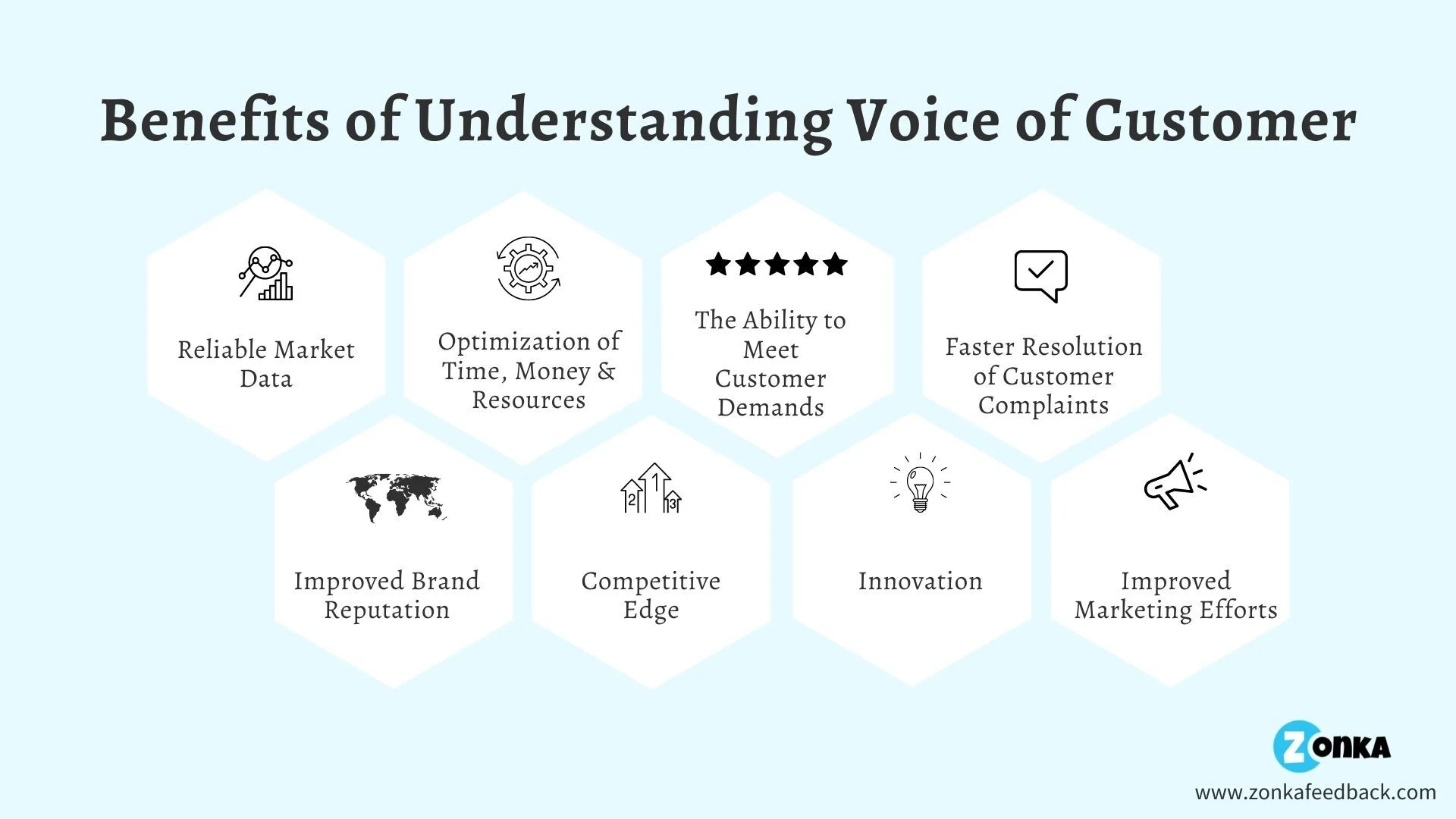
Ways to Capture the Voice of Customer
There are several effective ways to capture VoC data. Let’s read about the top ones in detail.
a. Customer Feedback Surveys
Capturing the voice of the customer involves deploying well-designed surveys at key touchpoints. For instance, post-transaction surveys gauge the number of satisfied customers and collect feedback, while mobile app users can share preferences and feature requests.
Microsurveys like CSAT surveys and Net Promoter Score surveys, which assess satisfied customers and the likelihood of recommending, can be deployed using multiple survey collection channels like email, SMS surveys, mobile app surveys, etc. Including a variety of question types, such as multiple-choice, and closed-ended questions, and follow-up survey with open-ended questions, ensures detailed responses.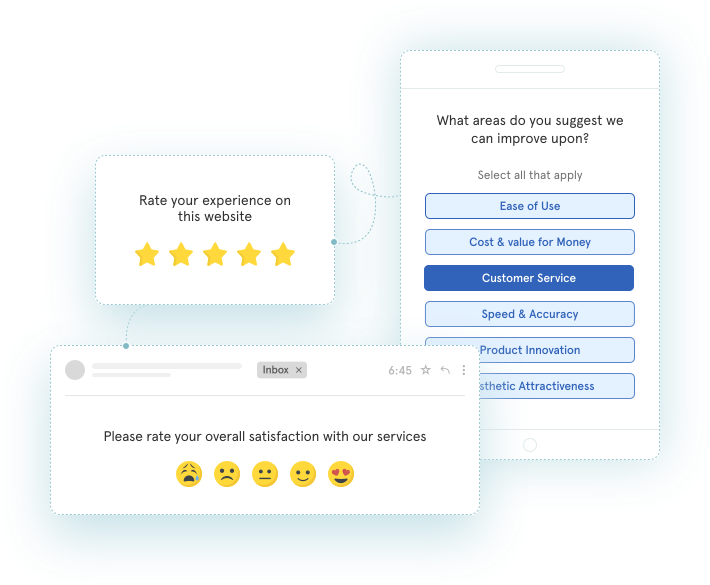
b. Website Analytics
Tracking how website visitors move and interact through website surveys can help you understand customers’ behaviors. While website analytics predominantly offer quantitative data, including metrics like click-through rates, page views, purchase patterns, and cart abandonment, their real power lies in their ability to pinpoint the underlying reasons for customer actions.
By integrating this quantitative data with qualitative insights, you gain a comprehensive understanding of customer behavior, which in turn enables you to enhance strategies for improving customer retention.
c. Interviews and Focus Groups
Customer interviews are a direct way to understand the voice of the customer that allows you to dig deeper into customer insights through follow-up questions. You can conduct a customer interview, i.e., have face-to-face conversations with target customers who visit your store, center, or company.
Similarly, you can create focus groups online to invite customer insights and engage with your brand. You can ask for customers’ feedback and strike up conversations to learn more about their behavior.
d. Phone, Email & Live Chat Customer Support
Leveraging phone, email, and live chat customer support for VoC involves proactively addressing customer concerns and analyzing interactions. This enables you to identify and resolve issues quickly, gain insights into customer sentiments, and improve the overall customer experience, improving satisfaction and loyalty.
Though you cannot manually read through every bit of customer support data, you can use sentiment analysis tools to tag customers' conversations and comments with keywords so you can segment data. This can help you highlight points like –
-
What are the most trending complaints?
-
What are the most urgent issues?
-
Who are the customers who may soon churn out?
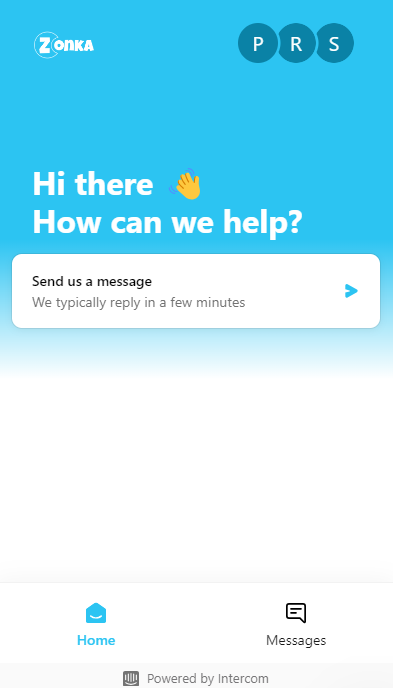
e. Social Media and Online Listening
Social media and online listening are powerful VoC methods. Monitoring comments, online customer reviews, and ratings on platforms like G2 and Capterra provide insights into customer opinions.
Similarly, social media platforms are one of the most powerful VoC methodologies since you can connect and share content with large networks with just a single click. Engaging with customers through comments, issue resolution, and follow-ups enhances brand reputation.
Use Cases of Voice of Customer Platform across Industries
The voice of the customer feedback serves as a powerful compass guiding businesses across various industries. Let us look at the top industries where they are highly impactful.
1. Banking
VoC in banking involves collecting and analyzing customer feedback across channels to enhance service quality. It enables the reduction of customer churn by identifying areas needing improvement. Banks can proactively address user concerns and increase customer loyalty through bank feedback system that drives from VoC surveys.
2. Insurance
In the insurance sector, VoC helps in measuring customer loyalty through methods like Net Promoter Score surveys. Companies like Lawley's utilize these surveys to understand customer loyalty and detect pain points in the customer journey. Additionally, identifying unhappy customers and proactively addressing their concerns helps in retaining valuable accounts.
3. Healthcare
Healthcare providers leverage VoC to collect patient feedback on various platforms. By asking health assessment questions and analyzing customer feedback, they gain insights into their business performance and customer experience. Voc strategy also allows them to identify customer pain points and enhance overall patient satisfaction.
4. Automotive Sector
In the automotive industry, VoC plays a crucial role in understanding customer perceptions, especially after events like car recalls. Brands use the automotive survey to understand customer needs and manage brand perceptions, including insights gained from areas as specific as customer feedback on driving simulation tests. This data can be invaluable for brands aiming to tailor market-specific strategies different from traditional PR based on different market responses.
This enhances customer experience and helps in identifying areas for product improvements through product feedback, ensuring that future vehicle offerings align more closely with consumer preferences and expectations.
5. Retail
Retailers utilize VoC data to stock products in line with customer demand and identify areas for store improvements. By collecting retail feedback through in-store kiosks or mobile apps, retailers can identify customer preferences and address issues like product availability, checkout speed, or store cleanliness to make real-time adjustments and enhance the overall shopping and customer experience.
6. Education
Educational institutions employ VoC to understand the expectations of students and parents. This facilitates the delivery of personalized education and identifies areas where expectations are unmet, such as the need for additional extracurricular activities or improvements in teacher-student ratios. VoC informs educational enhancements and ensures student and parent satisfaction.
Voice of the Customer Examples: Companies that Excelled
Incorporating the Voice of the Customer has become a strategic imperative for businesses seeking to adapt and excel in today's competitive landscape. Let us explore how leading companies have leveraged VoC efforts to revolutionize their industries.
Amazon
Amazon has built a world-class customer culture by incorporating the voice of the customer. They closely monitor customer reviews, ratings, and feedback on its platform. This information helps Amazon understand customer preferences and pain points.
An example of this is the development of the Amazon Echo, where customer feedback was used to enhance the smart speaker's features and capabilities. Amazon continually updates and expands Alexa's functions based on customer input, making it a powerful virtual assistant.
Source: Amazon
Zappos
Zappos, known for exceptional customer service, measures customer interaction in terms of emotional impact. They strive to understand how their brand and customer experience resonate emotionally with customers.
Zappos empowers its customer service representatives to give "wow gifts" to customers, such as sending flowers to a customer returning shoes due to a family illness. This personalized approach builds lasting customer relationships.
Source: Zappos
Slack
Slack, during its beta stage in 2013, selected Zendesk as its support solution. This choice allowed Slack to engage with customers through omnichannel communication and streamline feedback collection with a ticketing system.
They use the Zendesk API, integrated into the Slack platform, enabling users to contact support with a feedback command that generates a support ticket for quick resolution. Slack's focus is on listening to customer problems and interpreting their feedback to maintain and improve customer satisfaction scores.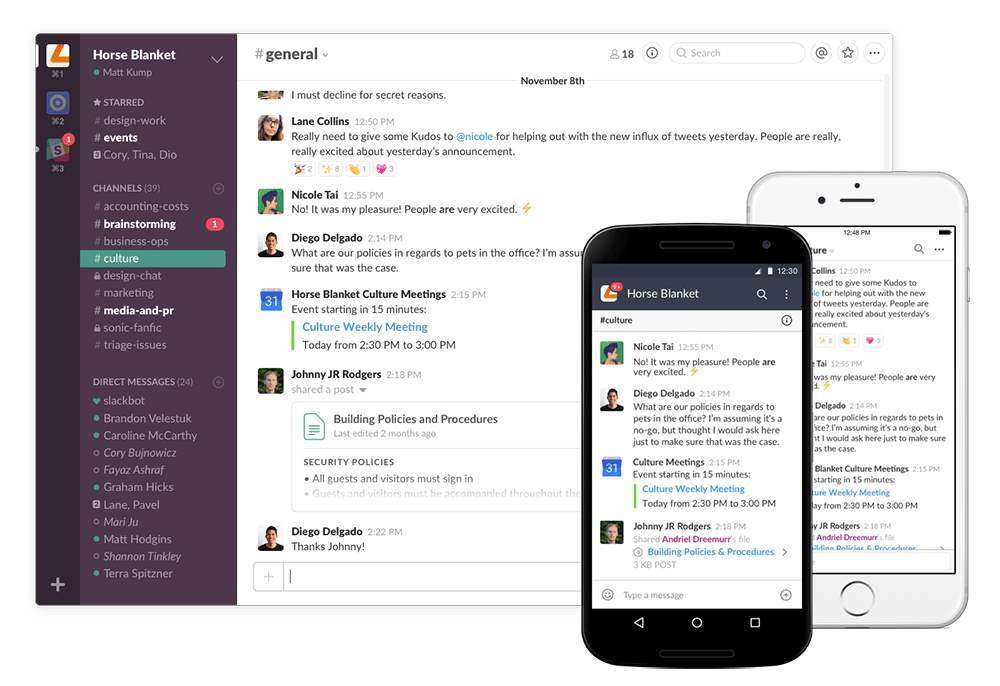
Source: Slack
How to Build an Effective Voice of the Customer Program?
Creating a successful voice of the customer program is at the heart of every successful customer experience program. It involves following a step-by-step process that can be easily implemented to increase customer lifetime value.
By breaking down the process into simple steps, you can effectively gather valuable insights from unsatisfied customers and happy customers to make informed decisions.
Let’s look at each of them.
1. Create a Goal/Vision
Begin your voice of the customer program by setting the specific business objective. Determine the key challenges you want to address, such as enhancing customer service, reducing churn, or improving marketing. Having a clear objective will guide your VoC strategy.
You might start with a single CX metric like Net Promoter Score (NPS) or Customer Satisfaction (CSAT) surveys, depending on your goal. This goal-driven approach ensures your customer data serves a purpose.
2. Create Customer Journey Maps & Identify Important Touchpoints
In your attempt to follow customer-centricity, not all touchpoints are created equal when it comes to gathering VoC data. To focus your efforts, create customer journey maps. These maps track the sequence of customer interactions with your brand, helping pinpoint the most valuable touchpoints.
It also helps in identifying the touchpoints that drive value, such as:
-
High-Value Moments of Truth: These reveal significant insights, like adding a product to the cart.
-
High-Value Customer Segments: Highlight frequent buyers or particular customer groups.
This approach ensures you collect high-quality data from essential touchpoints like store visits, billing, customer support, website interactions, and more.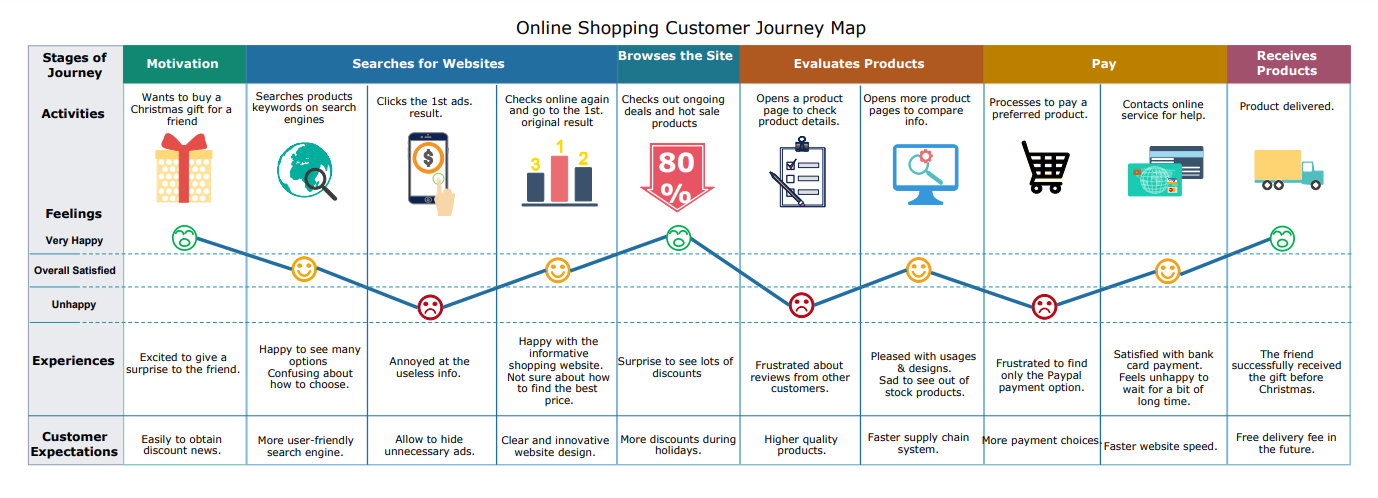
Source: Pinterest
3. Build an Omnichannel Strategy
In most businesses today, customers engage with brands through various channels. They may visit stores, prefer an online customer experience, or even combine both. It's crucial to assess all touchpoints for understanding customer needs and collecting reliable customer data.
You can employ methods like voice of the customer surveys for direct feedback on websites, mobile apps, or remote interactions. Use website analytics for tracking online activities and monitor online reviews and comments for online listening. This comprehensive approach captures the full spectrum of not only getting customer feedback but increasing the likelihood of getting positive feedback.
4. Select VoC Tools
Once you understand the data you need from your journey maps, select the appropriate voice of customer tools to achieve your feedback goals. For instance, if in-store foot traffic isn't translating to conversions, consider using kiosk surveys for customer satisfaction data. Likewise, track online brand discussions through social listening. These customer tools help to understand customer needs and uncover conversion barriers.
Voice of the customer tools fall into three categories::
-
Direct Feedback: Collects feedback directly from customers. These include:
-
Customer Feedback Surveys
-
Focus Groups
-
Customer Interviews
-
Customer Service Calls
-
Live Chat
-
-
Indirect Feedback: Monitors unsolicited customer feedback. These include:
-
Online Reviews
-
Customer Service Calls
-
-
Inferred Feedback: Collects insights based on customer behaviors. These include:
-
Click Stream Data
-
Purchase History
-
Social Networking Activities
-
Contact Center Data
-
5. Create a Collaborative Process
Executing a VoC program is not a one-person job since your VoC data can be used in different capacities. You will need to involve all the stakeholders and delegate jobs for each phase.
For example, customer data collected through support calls can be filtered by the customer service team and can be used by the product development team to enhance your business offering. So, define use cases of all forms of data and delegate responsibilities accordingly.
Even though a VoC tool can create, collect, and analyze customer experience surveys, you still need to find answers to certain questions at this stage which include:
-
Who will select the VoC survey questions or create the questionnaires?
-
Who will be involved in the decision-making process?
-
How will the output of a previous stage be used as input in the next stage?
6. Collect VoC Data
After you assign the important contributors to your VoC program, you can finally start getting data. Collect VoC data from all sources namely direct and indirect feedback like feedback surveys, focus groups, reviews, social media., etc, and measure data like Customer Satisfaction Score, Net Promoter Score, Customer Lifetime Value (CLV), and Customer Loyalty Index (CLI).
By leveraging diverse sources to collect feedback data, you can obtain a comprehensive view of customer sentiment and preferences and make informed decisions to enhance the customer experience and drive business improvements.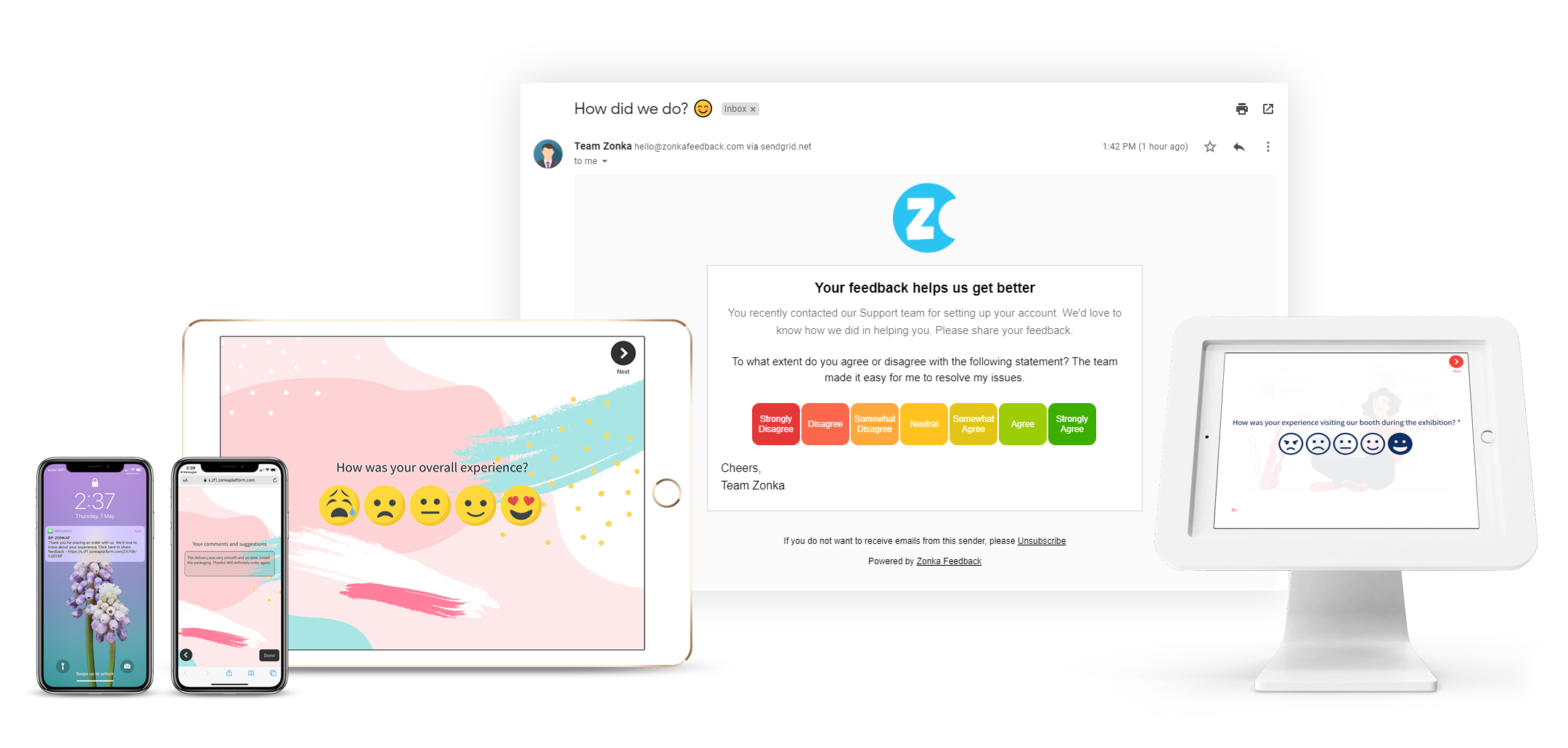
7. Track your KPIs
The customer data that you collect in the first phase of your VoC program will serve as Key Performance Indicators (KPIs) for your business. You can use these to understand the drivers of satisfaction and dissatisfaction.
Also, this information will help you prioritize the effective changes that you will need to make in order to deliver a remarkable customer experience. However, make sure that your KPI dataset is consistently updated.
8. Act on Customer Feedback
VoC data is useless if you do not act on customer feedback, especially if it is negative. So, make sure that you have a team in place that tracks if issues are being resolved and customers are being responded to.
Keeping customers in the loop and informing them about all the progress communicates to them how important their opinion is for your brand. Increasing customer retention is an important aspect of the VoC program. When customers feel heard and valued, they are more likely to stay, even after a negative experience, as they see their satisfaction as your top priority.
Voice of Customer Best Practices
Here are some best practices that you can keep in mind when seeking the voice of customer feedback.
a. Collect Customer Feedback at Multiple Touchpoints across Multiple Channels
To gain valuable insights that are inclusive, gather feedback at various stages of the customer journey. This can include points like post-purchase, post-support interactions, or even during onboarding. Utilize multiple channels such as email surveys, in-app surveys, website pop-up surveys, and social media monitoring.
Diversifying touchpoints ensures you capture feedback from different customer segments and situations, resulting in a more holistic view of customer sentiment.
b. Personalize User Experience
Personalized customer experience demonstrates that you value and understand your customers, leading to more meaningful feedback.
Tailor surveys and feedback collection methods to individual customer preferences and behaviors. Leverage user segmentation to send specific surveys to different customer segments, ensuring that questions are relevant to each group.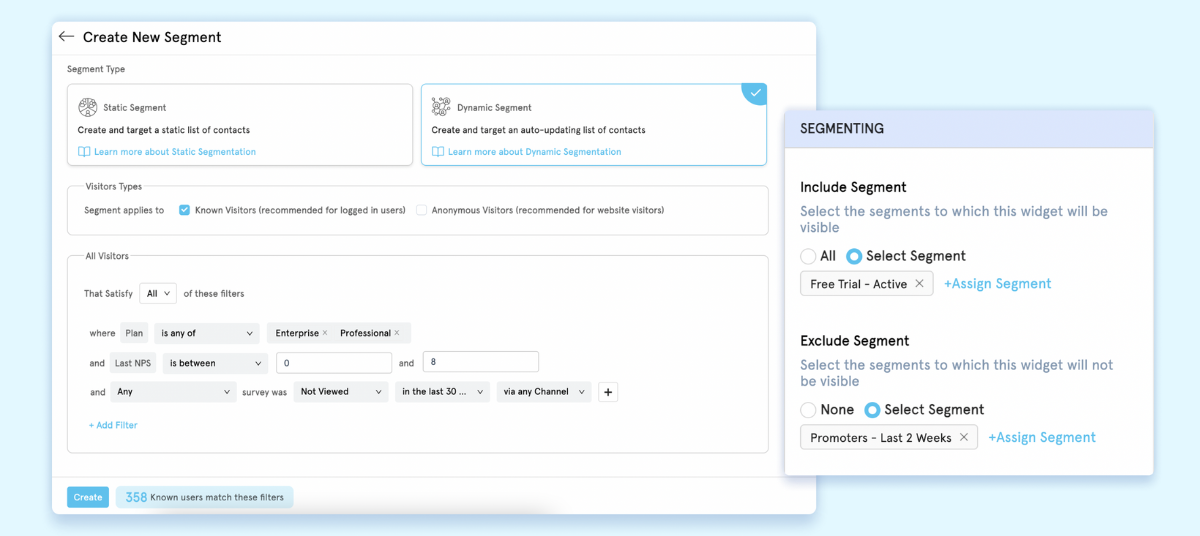
c. Collaborate Across the Team
Voice of the customer efforts should be distributed across departments for effective results. Collaborate across various teams, including customer support, marketing, product development, and sales. Each department can provide unique insights and contribute to improvements based on customer feedback.
Collaboration helps to align the organization's efforts with customer needs and foster a customer-centric culture.
d. Leverage Advanced Analytics to Get Insights
By using advanced analytics techniques like trends reports, tags reports, snapshot reports, insight reports, etc., you can extract deeper insights from customer data. Additionally, sentiment analysis, text mining, predictive analytics, and machine learning can help identify trends, anomalies, and emerging issues.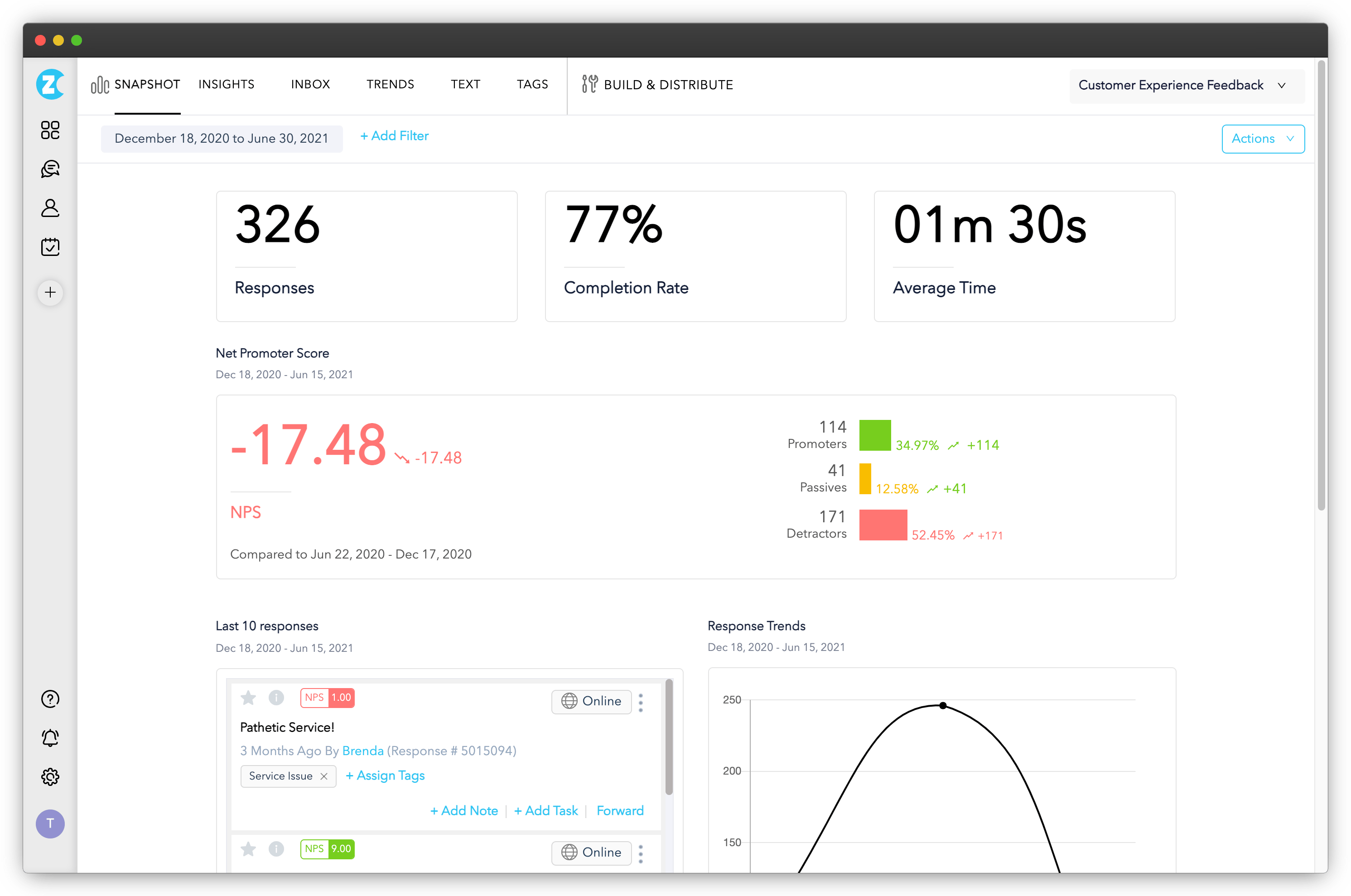
e. Transparency in Reporting
Maintain transparency in your VoC program by sharing results and actions taken with both your employees and customers. Internally, provide regular updates to team members to keep them informed about the impact of feedback on improvements.
Externally, inform customers about changes made based on their feedback and express appreciation for their input. Transparency builds trust and demonstrates a commitment to continuous improvement.
Conclusion
Incorporating the voice of the customers into your business strategy may require some adjustments and fresh approaches, but it's a transformative journey worth undertaking. By embracing a VoC program, you pave the way for customer success and long-term survival for your business.
By leveraging survey software like Zonka Feedback, you can simplify the process, allowing direct listening through intelligent feedback surveys. With customizable templates and insightful reports topped with features like workflow automation, user segmentation, and complaint tracking, you can make informed decisions, collect real-time customer feedback, close the feedback loop, and improve customer experiences.
Schedule a demo and see how it works for your business.
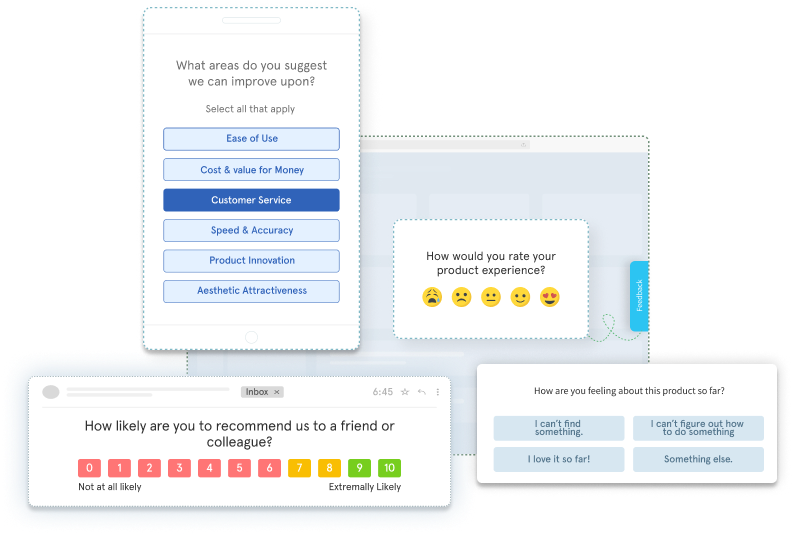
.jpg)


.png)







